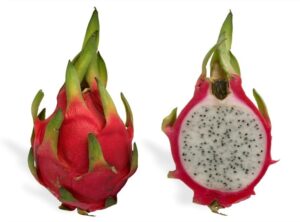Geography
In News: Centre to promote dragon fruit cultivation in 50,000 hectares.
- Following the footsteps of the Gujarat and Haryana Governments, the Centre has decided to promote the cultivation of dragon fruit, known as a super fruit for its health benefits.
- The Centre feels that considering the cost effectiveness and global demand for the fruit due to its nutritional values, its cultivation can be expanded in India.
- At present, the fruit is cultivated in 3,000 hectares; the plan is to increase cultivation to 50,000 hectares in five years.
Dragon Fruit
- The dragon fruit – Hylocereus undatus is indigenous to the Americas.
- It is a member of the cacti family.
- It is also known as ‘Pitaya’, ‘Pitahaya’, strawberry pear, noblewoman and queen of the night throughout the world.
Features:
- Its flowers are hermaphrodites (male and female organs in the same flower) in nature and open at night.
- The plant sustains yield for more than 20 years, is high in nutraceutical and good for value-added processing industries.
- It is a rich source of vitamins and minerals.

Climatic Condition:
- It is hardy and grows in diverse climatic conditions with varied soils, especially in the semi-arid and arid regions of India.
Popularity in India:
- The dragon fruit was introduced to home gardens in India in the 1990s.
- The low maintenance and high profitability of dragon fruits has attracted the farming community throughout India.
- The cost of cultivation is initially high. But the plant doesn’t need productive land; it gives maximum production from non-productive, less fertile area.
- Presently Mizoram tops among the States that cultivate this fruit.
- India is now importing about 15,491 tonnes of dragon fruits and has potential to match the production of China, where cultivation of the fruit takes place in 40,000 hectares, and Vietnam, which grows the fruit in 60,000 hectares.
Source: The Hindu
Previous Year Question
Q.1) Consider the following statements: (2021)
- Moringa (drumstick tree) is a leguminous evergreen tree.
- Tamarind tree is endemic to South Asia.
- In India, most of the tamarind is collected as minor forest produce.
- India exports tamarind and seeds of moringa.
- Seeds of moringa and tamarind can be used in the production of biofuels.
Which of the statements given above are correct?
- 1, 2, 4 and 5
- 3, 4 and 5
- 1, 3 and 4
- 1, 2, 3 and 5














